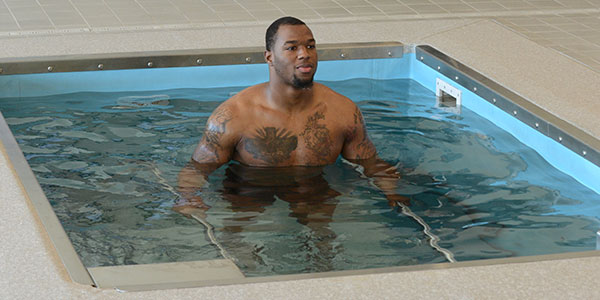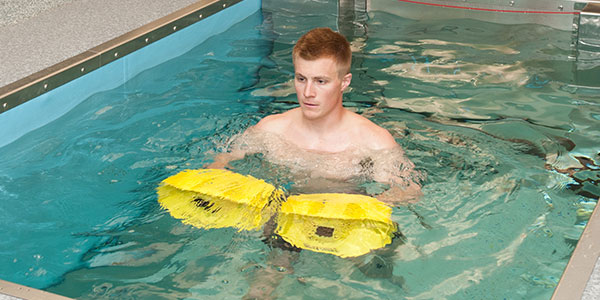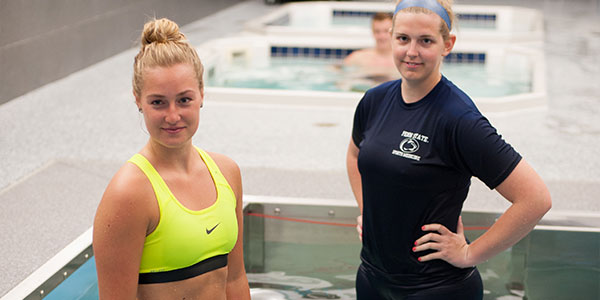
Jump to Sections:
- Common Injury Rehabilitation Timeframes
- Why Water Rehab Works to Accelerate Healing
- The Tools Needed for Onsite Aquatic Rehabilitation Therapy
- The People Needed for Onsite Aquatic Rehabilitation Therapy
- Three Examples of Exercises for Onsite Aquatic Rehabilitation Therapy
- Final Thoughts on Aquatic Therapy to Decrease Injury Rehabilitation Time
Common Injury Rehabilitation Timeframes
In general, patients are expected to accept the following injury rehabilitation timeframes (which are rough estimates)*:
- Achilles tendon ruptures: 4 to 6 months
- ACL repair: up to 6 months
- Bone fractures: 3 to 10 weeks
- Rotator cuff tendinopathy: 2 to 12 weeks
- Shoulder impingement: 2 to 12 weeks
- Shoulder separation: 2 weeks
- Sprains: a few days to several months
Note: These injuries are only examples of those commonly-seen. Patients may experience different injuries, or a combination of injuries, which will change expected healing times.
*Sources: National Institute of Health, U.S. Center for Sports Medicine, American Academy of Orthpaedic Surgeons, Mayo Clinic, University of California — Department of Orthopedic Surgery
The good news is that healing can sometimes be hastened. Depending upon the modalities utilized by the physical or occupational therapist, a patient can expect to see significant improvements over a shorter-than-average period of time. One of those modalities is aquatic therapy.
Request a Free Info Kit View Our Products Find a Pool Near You
Why Water Rehab Works to Accelerate Healing
Objective scientific studies, as well as reputable feedback from top clinicians, have indicated that water rehabilitation therapy can considerably cut patients’ expected rehabilitation times. In a healthcare environment, aqua rehab allows patients to more quickly move through the system without compromising outcomes. Because it is relatively pain-free, patients are more compliant; in fact, many physical and occupational therapists have reported that fewer patients miss or reschedule appointments because the water rehab makes it easier for them to move and regain function. Thus, more patients can be seen over a prescribed period of time, while receiving cutting edge care. As a result, every party involved wins: The patient can return to his or her preferred lifestyle activities faster than expected, and the healthcare facility can assist more people each year.
Similarly, aquatic therapy in a sports setting can get an athlete back “in the game” faster than ever. In terms of professional athletic teams, getting star players on the field, ice or court sooner rather than later can make a huge difference for team morale and reputation as well as the franchise’s finances. This makes it aquatic therapy a practical, safe solution for strength and conditioning coaches, athletic trainers and coaches.
Water has a well-deserved reputation for healing
Many people have turned to warm water as a healing element; in fact, it’s one of the primary reasons that families and individuals often purchase spas and hot tubs for their private use. They know that their bodies will feel more refreshed and relaxed after being in the water for a period of time. In fact, even veterinarians have prescribed aqua rehab for horses, dogs and cats (yes, even some felines enjoy the feeling of being in the water) who have suffered joint conditions.
Physical and occupational therapists are similarly using the natural properties of water to help their patients speed up recovery, minimize the loss of range of motion (especially important when the injury is located in a joint), increase blood circulation and decrease inflammation. In a therapy pool, patients feel up to 80% lighter than on land depending on the depth of the water surrounding them. Thus, land-based therapy options like walking (and even running) can be undertaken without fear of re-injury.
As Kelly McFarland, PT, DPT and owner of Premier Rehab Physical Therapy has noted: “[Aquatic therapy] is an amazing state of the art option to incorporate into a patient’s rehabilitation program. We have been able to progress patients’ programs more quickly with so many different diagnoses . . .” McFarland’s positive observations have been echoed by other therapy professionals who have helped patients recover faster from fractures, sprains, broken bones, joint surgeries, ACL tears/repairs and more by getting them moving in an aquatic therapy pool as quickly as possible.
Though statistics are only now being amassed on the popularity of aquatic therapy, its rate of prescription is absolutely increasing. According to figures compiled from the Centers for Medicare and Medicaid, Aquaticnet.com and the National Swimming Pool Foundation, water rehabilitation is being widely chosen around the United States:
- In private physical therapy settings, aquatic therapy is increasing in popularity as per Medicare’s yearly reported billings.
- Medicare Part B spent about $46 million on outpatient aquatic therapy eight years ago. That number has reputedly increased, and is expected to continue to rise as the Baby Boomer population ages.
The keys to instituting water rehabilitation therapy in a healthcare or sports setting are threefold: Have the best tools, hire the best people, and implement the best water rehab workout treatments.
The Tools Needed for Onsite Aquatic Rehabilitation Therapy
To institute aqua rehab options for patients recovering from an injury, the treatment location must have the right equipment to handle the job. Recommended items include:
- A warm-water therapy pool fitted with high-end technologies (e.g., underwater treadmill, secure handrails, variable-depth water, resistance jets, massage hose capabilities, video camera diagnostic capabilities.)
- Water therapy treatment tools and equipment such as aqua barbells, gloves, water fins, ankle weights and noodles.
- A mechanized lift to enable patients who are not fully mobile on land to easily and safely get into the pool. (A variable-depth pool can also serve this function.) Large safe stairs are necessary for pool entry, as ladders can be a hindrance to people with injuries. (Ladders can also be difficult, if not impossible, for some seniors to navigate.)
- An area dedicated to patients who need to change before and after treatment.
- Supplies to cover any healing wounds using waterproofing techniques, to guard patients against infections and keep the therapy pool free from unwanted bacteria.
Each of these items will provide both the patient and the physical or occupational therapist a wide range of possibilities in terms of water therapy exercises. Thus, any number of injured body parts can be securely manipulated, and the muscles, tendons and bones around those areas can also be put into motion, speeding up the overall healing process.
Request a Free Info Kit View Our Products Find a Pool Near You
The People Needed for Onsite Aquatic Rehabilitation Therapy
Physical and occupational therapists who work with patients in a water-based environment must have the proper training, expertise and passion for their roles. For instance, in terms of timing regarding aquatic therapy treatments, the professional must be well-versed as to when to put the patient in the pool, and how hard to “push” the patient.
In a 2011 article by Nancy A. Melville, Timing of Aquatic Therapy for Knee, Hip Arthroplasty Matters, the author tackles this subject. Melville asserts that when aquatic therapy is begun six days after total knee arthroplasty, the patient outcomes increased in comparison with beginning therapy treatments 14 days post-surgery. She continues by claiming that aquatic therapy is helpful to those who have undergone knee arthroplasty because water rehab relieves a patient’s body weight, enabling muscles to strengthen.
Melville touches briefly upon the subject of open (or partially-open) wound dressings. Again, this is an area where a knowledgeable physical or occupational therapist performing water therapy treatment should have full confidence in his or her abilities. Waterproofing methods exist to seal off wounds, and those methods should be implemented whenever necessary.
Finally, the physical and occupational therapist performing aqua rehab must be comfortable working with each patient’s personal desires. Some individuals are hesitant to get their faces or hair wet, which can limit the exercises they are willing to perform. Others may have a tremendous fear of falling, so the physical or occupational therapist must provide a sense of stability for the patient at all times. Thus, flexibility will always be part of the experience to ensure the physiological and psychological results remain positive.
Three Examples of Exercises for Onsite Aquatic Rehabilitation Therapy
Finding exercises for aquatic rehabilitation therapy can be challenging. It’s one reason HydroWorx has created an expansive video library to give professionals a wealth of ideas in terms of how to rehabilitate patients using the therapy pool. In the end, though, it’s important for all therapy professionals to keep the communication open between them and their patients. That way, they can ensure that patient confidence and ability is not being compromised by uncomfortable protocols.
Below are three aqua rehab exercises that have been used by well-regarded physical therapists. They can be modified as necessary, and repetitions can be fitted to the patient’s personal needs and stamina.
- Exercises for shoulder injuries — Shoulder injuries (e.g., arthritis, rotator cuff problems, shoulder impingement, upper arm strains and sprains) affect approximately seven million Americans every year. Though not all will need surgery or require therapy, many will seek out help. Exercises for patients who fit into this category include:
- Making figure eights or circles with arms outstretched in the water while standing. This can be done with or without water weights. Resistance jets can offer an additional challenge to this exercise.
- Lying face-down on the water (using a flotation device as well as a snorkel and mask) and making “snow angels” to promote a better range of motion.
- Using the pool noodle in a “U” shape to “push down” into the water.
- Walking underwater or on an underwater treadmill to regain natural arm swing.
Click here for video case studies on shoulder rehabilitation exercises
- Exercises for total knee replacements — The Centers for Disease Control report that there are approximately 719,000 total knee replacement surgeries annually. Each of these patients will require some form of physical therapy to ensure that the device is functioning properly, and the patient can return to a normal gait and balance. Below are some exercises that have been beneficial for total knee replacement patients who have undergone water therapy:
- Gentle squats while holding onto the edge of the pool, eventually moving into lunges.
- Straight-leg flexion extension exercises while patient is holding onto either the edge of the pool or steady guardrails.
- Using water fins, patients can alternate from side to side and practice abduction and adduction. This strengthens the muscles around the knee. Resistance jets can offer an additional challenge to this exercise.
- Walking underwater or on an underwater treadmill to regain motion
Click here for video case studies on knee rehabilitation exercises
- Exercises for Achilles tendon conditions — The Achilles tendon can rupture or sprain, leaving a patient in need of a pool protocol to help promote healing time post-surgery (or post-injury if surgery is not needed.) If surgery has been performed, aquatic therapy may be utilized fairly soon after post-op. Some exercises for this type of injury include:
- Slowly walking on the underwater treadmill, focusing on push-off and knee-bend.
- Doing a “side shuffle” on the underwater treadmill at slow speed.
- After several weeks, jogging on the treadmill is a possibility.
Click here for video case studies on Achilles tendon rehabilitation exercises
Final Thoughts on Aquatic Therapy to Decrease Injury Rehabilitation Time
Just as every patient is unique, so will his or her recovery be. However, time and again, the HydroWorx pool has been used by physical and occupational therapists in healthcare and sports settings to speed up healing. By taking into consideration the type of injury the patient has had, as well as his or her physician’s prescribed therapy treatments, a therapy professional can create a personalized water rehab workout that can take place days — or even weeks — before dry land therapy begins.
Not only does offering patients a warm-water therapy pool make sense from a physical perspective, but it affords the healthcare facility the benefits of working with a larger population yearly. Hence, the equipment pays for itself in a short period of time, and then enables the healthcare entity to begin increasing its profitability through productivity.
Request a Free Info Kit View Our Products Find a Pool Near You
Page Updated on: November 10, 2020



